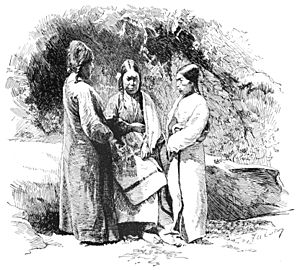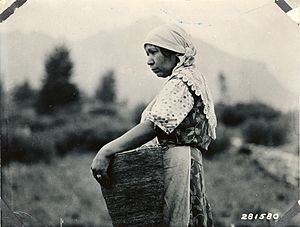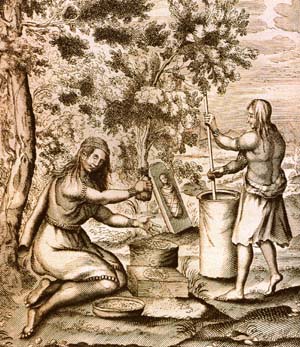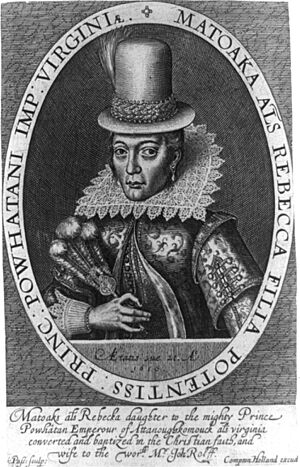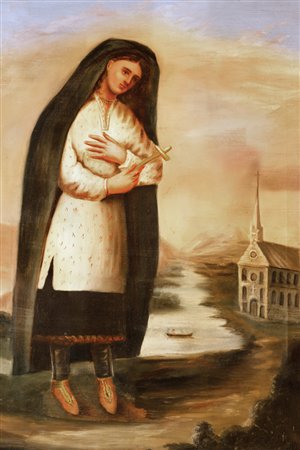Native American women in Colonial America facts for kids
Before and during the time when Europeans started settling in North America, Native American women had very important roles in their societies. These roles were often different from what European settlers expected. Many women were strong leaders in their tribes. For example, Cherokee women helped with important agreements and treaties with the United States. Women in the Haudenosaunee Confederacy were, and still are, political leaders who even choose the chiefs. Other women focused on caring for children and preparing food. Their specific jobs changed from one tribal group to another. In many tribes, like the Algonquins and the Six Nations of the Haudenosaunee, women were in charge of farming. They grew crops while the men often went hunting for long periods. Because of this, women played a huge part in family life and had a lot of say in their tribe's social and economic decisions.
Contents
What Was Life Like for Native American Women?
The daily life of Native American women changed from tribe to tribe and from region to region. However, some general ideas were common. Women were often seen as very important because they were mothers and raised healthy families. Many tribes believed they came from a woman, and their stories often talked about a "mother earth."
Women were trusted with managing their tribe's farms. They were responsible for growing and gathering vegetables and plants for their people. Tribal women, like the Algonquians, planted their fields carefully. They made sure the land stayed healthy for future use. After a piece of land was used for a while and its soil needed rest, women decided when and where to clear new fields. This allowed the old fields to recover. Women in the Haudenosaunee tribes often controlled how food was shared among their people. Because they were seen as having spiritual power, women in some tribes could be healers for small injuries. Men were more often the main spiritual leaders, chiefs, and herbalists.
Women as Leaders and Warriors
Some Native American groups were known for having women in powerful political positions. This was more than just controlling food or being "agricultural scientists." Older women in the Haudenosaunee tribes met in groups called clans. They decided who would be on the tribe or village council. This included choosing the 49 chiefs within their confederacy.
Women also learned skills like hunting and fishing. Some, like Weetamoo, who was a female chief of the Pocasset Wampanoag tribe, even led their people in battle. It was not unusual for women to fight. Women often entered battles to protect their husbands or brothers who had fallen. Some women earned special warrior titles for their bravery. Women who were tribal leaders, such as Queen Anne and Weetamoo, were known for their part in wars.
Beliefs and Traditions
During the colonial period, Native American religion was a big part of all Native life. It shaped their culture, art, history, politics, and how they traded. Many Native people believed that both animals and plants had spirits.
The Apaches, and other Native American people, believed that women had spiritual power. Some respected older women used their important spiritual and social authority within the tribe.
How Did Gender Roles Work?
Traditional gender roles changed when Europeans came to North America. Before Europeans arrived, several Native American cultures were matrilineal. This means that children belonged to their mother's family or clan, not their father's. After marriage, husbands would leave their own homes and join their wives' families.
For example, in the 1700s, Cherokee motherhood was very important. It included not just the mother-child bond, but also women's wider family connections. It also included their role in farming and their political power as mothers of the Cherokee nation. The Cherokee showed how important motherhood was by calling all female relatives "mother." The Hopi people were both matriarchal (meaning women had a lot of power) and matrilineal. Women and men had equal roles in their society. Women also took part in Hopi politics.
In many Native American cultures, even though male family members might arrange marriages, wives had control over whether they wanted a divorce. In the Haudenosaunee tribes and the Cherokee Nation, a woman could show she wanted a divorce by leaving her husband's belongings outside their door.
When Europeans arrived, some tribes started to adopt a system where men had more power. This was similar to European culture. For example, the Cherokee Council passed laws that changed how property was passed down and how citizenship was decided. These new laws favored men.
In the Lakota tribes, there was a story about the "Double Woman Dreamer." This was a woman who acted in masculine ways and had special powers. This idea led to "warrior women" or "manly hearted women" who acted like men in hunting and fighting. There was also a similar role for men called "berdache," where a man could dress and take on the responsibilities of a woman. Today, this role is often called "two-spirit" in Native American cultures.
In the Apache tribe, girls are not seen as women until they go through the Sunrise Ceremony. This is a sacred four-day celebration where they dance to songs and prayers. They do this to gain the power of "White Painted Woman" and accept their role as women of the Apache nation.
How Europeans Affected Native Women
When Europeans came, they claimed land and often forced Native Americans off their homes. Some Native Americans welcomed these new people. They shared their skills and belongings. However, many Europeans took advantage of this kindness. They started building their own nation on tribal lands, encouraging more Europeans to move to North America. Besides violently removing many Native Americans from their land, Europeans also brought new diseases. These diseases caused many deaths among the tribes and lowered the birth rate of Native American people. As more Europeans arrived, the Native American population decreased greatly.
One way Europeans affected Native American women was through marriage. In many Northeast tribes, Native women became guides, interpreters, and wives for fur traders. These marriages seemed to create a friendship between cultures. However, when the fur traders decided to go back to Europe, they would often leave their wives. Sometimes, they even treated them like property and passed them to another trader. The children from these marriages were not under the control of their mothers, as was traditional in Native American society. Instead, many of these children were sent away by their fathers to get a Christian education.
Some colonists wanted to change Native women to Christianity. Pocahontas' story is an example of marriages that created alliances between tribes and colonists. A famous picture of Pocahontas shows her in stiff European clothes, looking very different from her Native identity. Some Native women did become Christians. The most famous was Kateri Tekakwitha, known as the Lily of the Mohawks. Tekakwitha learned about Catholicism from her mother, who had been baptized by French missionaries. Tekakwitha converted to Catholicism when she was 19. This decision caused her tribe to treat her harshly.
Important Native American Women
Here are some notable women from this time period:
- Queen Anne of the Pamunkey tribe became a leader between 1706 and 1715. Her tribe was the most powerful in the Powhatan Confederacy. She became leader after her aunt, Cockacoeske, passed away. European colonists called her "Queen Anne" because of her high position, similar to their own royalty. When General Berkeley asked for warriors from her tribe to help stop Bacon's Rebellion, Anne first said no. She explained that her people had been treated badly by the white colonists for many years. After the governor promised better treatment and alliances, Anne agreed to send warriors.
- Pocahontas was the daughter of a well-known Algonquin chief of Powhatan. Pocahontas played a key role in the dealings between Native Americans and European colonists. She is said to have saved the life of Englishman John Smith by almost sacrificing herself. After John Smith returned to England, she married a member of her tribe. Later, she was captured during the first Anglo-Powhatan War. The English kept her, taught her from the Bible, and gave her a Christian name: Rebecca. She later married John Rolfe and helped create a time of peace between the Powhatan tribes and the colonists.
- Queen Weetamoo was a chief of the Pocasset Wampanoag tribe. She became chief after her father. Weetamoo was skilled in hunting, fishing, and swimming, along with learning the tasks of other women in her tribe. She married five times, including to the son of Massasoit, who is known for having the first Thanksgiving with the Pilgrims. She kept this important alliance strong through her marriage. Weetamoo offered her warriors to fight in King Philip's War. She even led a successful attack on the colonists. After King Philip was betrayed and the war ended, the colonists celebrated their victory by beheading King Philip and other leaders. Weetamoo tried to escape but fell into the Taunton River and drowned.
- Nancy Ward, from the Cherokee Wolf Clan in Tennessee, was a very important historical figure. She was given the title "Ghighau" or "Beloved Woman" at just 18 years old. This happened after she led her people to victory in the Taliwa Battle of 1755 between the Cherokee and the Creeks. Her husband, King Fisher, had fallen in battle, and she turned the tide. It is said that her entering the battle was the turning point that led her people to win, even though the Cherokee were outnumbered. The "Beloved Woman" title was the highest honor a woman could receive. The Cherokee believed that the Great Spirit used the "Beloved Woman" to speak to the people. In this role, she sat with the Peace Chief and War Chief during council meetings. She would speak her mind and share her opinions. Nancy Ward held this title for life and was a vital part of the Women's Council.


